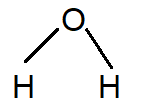
How does isopropyl alcohol differ from water in polarity?
Answer
540.6k+ views
Hint: Isopropyl alcohol is the simplest example of secondary alcohols. Polarity is defined as the dipole moment. It occurs with a negatively charged end and a positively charged end. Polar molecules must have polar bonds in the structure which make them polar.
Complete step by step answer:
In order to determine the polarity of isopropyl alcohol we have to consider its structure. In the structure of isopropyl alcohol, one of the hydrogen atoms is replaced by a hydrocarbon group. Generally, hydrocarbons are nonpolar in nature due to the low polarity of the hydrocarbon group causing low polarity in the isopropyl alcohol and make it less polar.

But in the case of water, the structure of water has two hydrogen atoms attached to one oxygen atom. In the molecule of water the bonds are attached in such a way that the dipoles of oxygen-hydrogen bonds add constructively. Due to the difference in electronegativity of oxygen and hydrogen this molecule is much more polar.

That’s why isopropyl alcohol is less polar than water.
Additional information:
In a molecule there is one or more chemical bonds present between molecular orbitals of different atoms. Polarity of molecules depends on the electronegativity difference between the bonds as explained above. Polarity also occurs due to an asymmetric arrangement of nonpolar covalent bonds and non-bonding pairs of electrons known as a full molecular orbital.
Note: In more simple words, polarity is also called separation of charge because electrons consist of negative charge and the unequal sharing of electrons in a bond causes the formation of electric dipole that is a separation of positive and negative electric charge.
Complete step by step answer:
In order to determine the polarity of isopropyl alcohol we have to consider its structure. In the structure of isopropyl alcohol, one of the hydrogen atoms is replaced by a hydrocarbon group. Generally, hydrocarbons are nonpolar in nature due to the low polarity of the hydrocarbon group causing low polarity in the isopropyl alcohol and make it less polar.

But in the case of water, the structure of water has two hydrogen atoms attached to one oxygen atom. In the molecule of water the bonds are attached in such a way that the dipoles of oxygen-hydrogen bonds add constructively. Due to the difference in electronegativity of oxygen and hydrogen this molecule is much more polar.

That’s why isopropyl alcohol is less polar than water.
Additional information:
In a molecule there is one or more chemical bonds present between molecular orbitals of different atoms. Polarity of molecules depends on the electronegativity difference between the bonds as explained above. Polarity also occurs due to an asymmetric arrangement of nonpolar covalent bonds and non-bonding pairs of electrons known as a full molecular orbital.
Note: In more simple words, polarity is also called separation of charge because electrons consist of negative charge and the unequal sharing of electrons in a bond causes the formation of electric dipole that is a separation of positive and negative electric charge.
Recently Updated Pages
The number of solutions in x in 02pi for which sqrt class 12 maths CBSE

Write any two methods of preparation of phenol Give class 12 chemistry CBSE

Differentiate between action potential and resting class 12 biology CBSE

Two plane mirrors arranged at right angles to each class 12 physics CBSE

Which of the following molecules is are chiral A I class 12 chemistry CBSE

Name different types of neurons and give one function class 12 biology CBSE

Trending doubts
One Metric ton is equal to kg A 10000 B 1000 C 100 class 11 physics CBSE

What is 1s 2s 2p 3s 3p class 11 chemistry CBSE

Discuss the various forms of bacteria class 11 biology CBSE

State the laws of reflection of light

Explain zero factorial class 11 maths CBSE

An example of chemosynthetic bacteria is A E coli B class 11 biology CBSE




